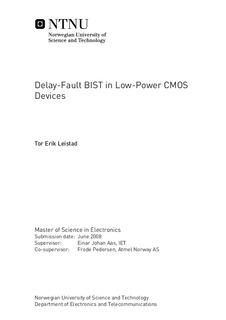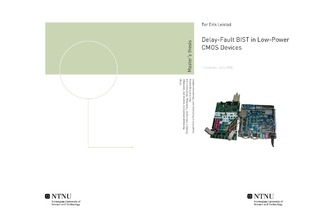| dc.contributor.advisor | Aas, Einar Johan | nb_NO |
| dc.contributor.advisor | Pedersen, Frode | |
| dc.contributor.author | Leistad, Tor Erik | nb_NO |
| dc.date.accessioned | 2014-12-19T13:43:32Z | |
| dc.date.accessioned | 2015-12-22T11:41:07Z | |
| dc.date.available | 2014-12-19T13:43:32Z | |
| dc.date.available | 2015-12-22T11:41:07Z | |
| dc.date.created | 2010-09-03 | nb_NO |
| dc.date.issued | 2008 | nb_NO |
| dc.identifier | 347617 | nb_NO |
| dc.identifier | ntnudaim:4226 | |
| dc.identifier.uri | http://hdl.handle.net/11250/2369125 | |
| dc.description.abstract | Devices such as microcontrollers are often required to operate across a wide range of voltage and temperature. Delay variation in different temperature and voltage corners can be large, and for deep submicron geometries delay faults are more likely than for larger geometries. This has made delay fault testing necessary. Scan testing is widely used as a method for testing, but it is slow due to time spent on shifting test vectors and responses, and it also needs modification to support delay testing. This assignment is divided into three parts. The first part investigates some of the effects in deep submicron technologies, then it looks at different fault models, and at last different techniques for delay testing and BIST approaches are investigated. The second part suggests a design for a test chip, including a circuit under test (CUT) and BIST logic. The final part investigates how the selected BIST logic can be used to reduce test time and what considerations needs to be made to get a optimal solution. The suggested design is a co-processor with SPI slave interface. Since scan based testing is commonly used today, STUMPS was selected as the BIST solution to use. Assuming that scan already is used, STUMPS will have little impact on the performance of the CUT since it is based on scan testing. During analysis it was found that several aspects of the CUT design affects the maximum obtainable delay fault coverage. It was also found that careful design of the BIST logic is necessary to get the best fault coverage and a solution that will reduce the overall cost. The results shows that a large amount of time can be saved during test by using BIST, but since the area of the circuit increases due to the BIST logic it necessarily don t mean that one will reduce cost on the overall design. Whether or not a BIST solution will result in reduced cost will depend on the complexity of the circuit that is tested, how well the BIST logic fits this circuit, how many internal scan chains can be used, and how fast scan vectors can be applied under BIST. In this case it looks like the BIST logic is not well suited to detect the random hard to detect faults. This results in a large amount of top up patterns. This combined with the large area of the BIST logic makes it unlikely that BIST will reduce cost of this design. | nb_NO |
| dc.language | eng | nb_NO |
| dc.publisher | Institutt for elektronikk og telekommunikasjon | nb_NO |
| dc.subject | ntnudaim | no_NO |
| dc.subject | SIE6 elektronikk | |
| dc.subject | Krets- og systemkonstruksjon | |
| dc.title | Delay-Fault BIST in Low-Power CMOS Devices | nb_NO |
| dc.type | Master thesis | nb_NO |
| dc.source.pagenumber | 102 | nb_NO |
| dc.contributor.department | Norges teknisk-naturvitenskapelige universitet, Fakultet for informasjonsteknologi, matematikk og elektroteknikk, Institutt for elektronikk og telekommunikasjon | nb_NO |

